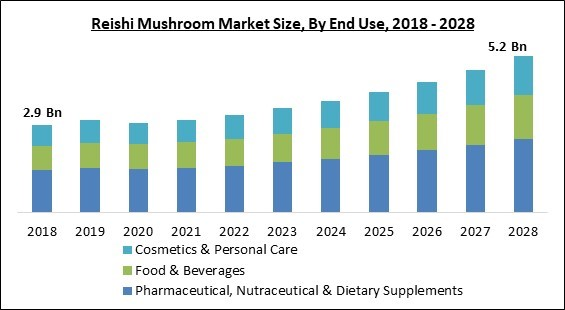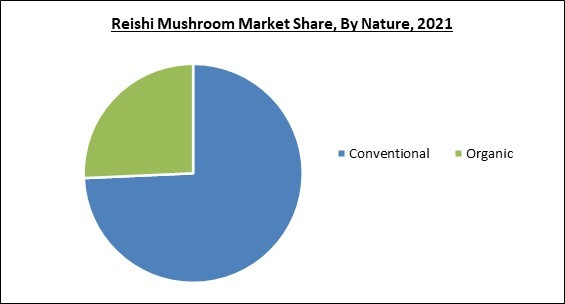The reishi mushroom has been utilised in traditional Chinese medicine. It is deep crimson in colour, has a brilliant surface, and a woody touch. These mushrooms, which are often grown on plum and oak trees and are frequently used in Chinese medicine, now have a wider geographic distribution. The reishi mushroom has brown spores, long stalk, and a fan-shaped cap with such a shiny, varnish-coated look. It is a purplish-brown fungus.
Reishi prefers the Japanese plum tree, though it can also be found on oak, and it thrives on dead wood or tree stumps. Although it is grown all over Asia, the mushroom is native to Japan, China, and North America. Reishi cultivation is a protracted and challenging procedure. Aoshiba (blue reishi), Kuroshiba (black reishi), Kishiba (yellow reishi), Akashiba (red reishi), Shiroshiba (white reishi), and Murasakishiba are the six various colours that the reishi can be found in (purple reishi).
Mushroom cultivation takes place in an environment with the right ventilation, lighting, humidity, nutrients, soil pH levels, and air pressure. Riboflavin, Vitamin D, potassium, and selenium are all abundant in mushrooms and provide a number of health benefits, including helping people control their weight, increasing their immune, and lowering their chance of developing a number of chronic diseases.
During the forecast years, the market is expected to rise due to the rising commercial consumption of mushrooms in cafeterias, supermarkets, restaurants, and hotels. Customers' shifting eating tastes toward adopting vegan cuisine and the market's increased demand for meat alternatives are some other reasons driving the market. Reishi mushrooms are becoming more and more popular because of its high protein content as the vegan culture grows and there is a demand for meat alternatives.
COVID-19 Impact Analysis
The outbreak of the COVID-19 pandemic has significantly impacted various sectors of the business domain. The imposition of various restrictions like ban on imports & exports and travel ban across borders has negatively impacted the production of reishi mushroom. The market for reishi mushrooms has been significantly damaged by the spread of COVID-19 since there are not enough workers, which lowers manufacturing capacity. Additionally, growers had to rely only on supermarkets and online retailers to market the mushroom goods as wholesale markets had to close.Market Growth Factors
Growing Popularity of Functional Food and Dietary Supplements
Over the past few years, there has been a significant change in the dietary and lifestyle patterns of people all over the world. Consumer awareness of lifestyle disorders is growing as a result of urbanization and consumerism, which prompted a sharp increase in the intake of synthetic food products. Consumers are consequently gradually turning to functional foods and beverages which are marketed as having advantages beyond simple nutrition. These goods offer high nourishment and lower the chance of getting sick.High Usage of Reishi Mushrooms as Immunity Booster in Various Food Products
Many immune-boosting benefits of reishi mushrooms have been proven in both conventional therapy and scientific studies. This may be due to the plant's high concentration of beneficial phytochemicals, such as peptidoglycans, polysaccharides, and triterpenoids. Reishi mushrooms have been shown in numerous studies to enhance the production of white blood cells, which are essential for fighting cancer and infectious diseases. These benefits are particularly noticeable in people who already have illnesses and medical issues. In China and Japan, reishi mushroom is used for many years as a cancer cure.Market Restraining Factors
Availability of Various Alternatives of Reishi Mushroom
Reishi mushrooms are notoriously bitter and chewy, therefore their flavour is not well known. As a result, dishes rarely include reishi mushrooms. When they do appear in a dish, it usually just as a finely-grained garnish dispersed over top. Instead, most individuals use reishi supplements, extracts, powders, tinctures, and teas to get the nutritional benefits of the plant without really tasting it. Reishi mushroom alternatives such as Rooibos tea, Golden milk, and Golgi berries all provide comparable nutritional benefits.End Use Outlook
By end use, the reishi mushroom market is classified into Food & beverages; Pharmaceutical, nutraceutical & dietary supplements; and Cosmetics and personal care. Pharmaceutical, nutraceutical & dietary supplements segment recorded the highest revenue share in the reishi mushroom market in 2021. Reishi mushrooms have long been utilized for their therapeutic effects due to their great medicinal value. The use of reishi mushrooms in dietary supplements has accelerated due to research and development. The market for reishi mushrooms is also expanding as a result of customers' increased interest in plant-based supplements.Form Outlook
On the basis of form, the reishi mushroom market is bifurcated into Liquid and Powder. The liquid segment recorded a significant revenue share in the reishi mushroom market in 2021. Less contaminants are present in the liquid form of the mushroom extract, which is crucial if a consumer chooses to use reishi mushroom supplements for a certain outcome. In addition, compared to powder, liquid forms of mushrooms offer concentrated nourishment. Another important consumer component is on-the-go beverages, which may be quickly added to.Nature Outlook
Based on nature, the reishi mushroom market is divided into Organic and Conventional. Conventional segment recorded the highest revenue share in the reishi mushroom market in 2021. Mushrooms from conventional sources are quite inexpensive and frequently utilized in industrial production. They are more affordable and offer a broader variety of items than organic reishi mushroom products. In addition, many consumers are preferring these kinds of mushroom, which is expected to accelerate the growth of the segment over the forecast period.Regional Outlook
Region-wise, the reishi mushroom market is analyzed across North America, Europe, Asia Pacific and LAMEA. Asia Pacific emerged as the leading region in the reishi mushroom market with the maximum revenue share in 2021. This is due to the fact that reishi mushroom products have been quite popular and widely used in the area for a very long time. The biggest producer and user of reishi mushroom products has additionally been China. Along with that, the high popularity of different kinds of mushrooms are contributing to the growth of the regional market.The market research report covers the analysis of key stake holders of the market. Key companies profiled in the report include Hokkaido Reishi Co. Ltd., Alphay International, Inc., Bio-Botanica, Inc., Bristol Botanicals Limited, Ron Teeguarden Enterprises, Inc., DXN Holdings Bhd., Xi'an Greena Biotech Co., Ltd., Nammex, JHS Natural Products, Inc. (Mushroom Science)
Scope of the Study
Market Segments Covered in the Report:
By End Use- Pharmaceutical, Nutraceutical & Dietary Supplements
- Food & Beverages
- Cosmetics & Personal Care
- Powder
- Liquid
- Conventional
- Organic
- North America
- US
- Canada
- Mexico
- Rest of North America
- Europe
- Germany
- UK
- France
- Russia
- Spain
- Italy
- Rest of Europe
- Asia Pacific
- China
- Japan
- India
- South Korea
- Singapore
- Malaysia
- Rest of Asia Pacific
- LAMEA
- Brazil
- Argentina
- UAE
- Saudi Arabia
- South Africa
- Nigeria
- Rest of LAMEA
Key Market Players
List of Companies Profiled in the Report:
- Hokkaido Reishi Co. Ltd.
- Alphay International, Inc.
- Bio-Botanica, Inc.
- Bristol Botanicals Limited
- Ron Teeguarden Enterprises, Inc.
- DXN Holdings Bhd.
- Xi'an Greena Biotech Co., Ltd.
- Nammex
- JHS Natural Products, Inc. (Mushroom Science)
Unique Offerings from the Publisher
- Exhaustive coverage
- The highest number of Market tables and figures
- Subscription-based model available
- Guaranteed best price
- Assured post sales research support with 10% customization free
Table of Contents
Companies Mentioned
- Hokkaido Reishi Co. Ltd.
- Alphay International, Inc.
- Bio-Botanica, Inc.
- Bristol Botanicals Limited
- Ron Teeguarden Enterprises, Inc.
- DXN Holdings Bhd.
- Xi'an Greena Biotech Co., Ltd.
- Nammex
- JHS Natural Products, Inc. (Mushroom Science)










